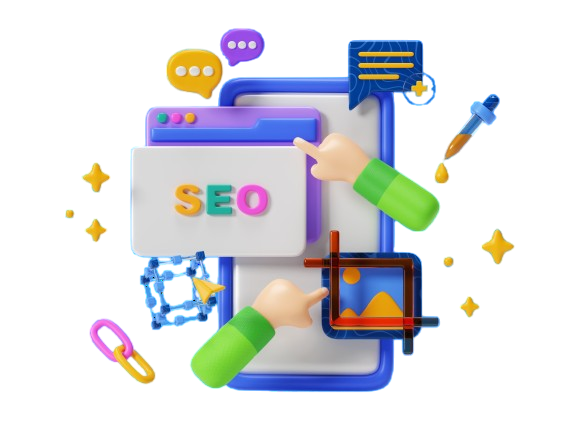Having a website is insufficient in the digitally savvy world of today. Your clients are looking for goods and services online, regardless of whether you are a tiny neighborhood store or a large eCommerce enterprise. Search Engine Optimization (SEO) is useful in this situation. Even small businesses and eCommerce retailers may utilize SEO to increase traffic, visibility, and sales with the correct tactics, even though it may seem complicated to novices.
In this beginner’s guide, we’ll go over the most important SEO methods for small businesses and eCommerce websites.

1. Understand the Basics of SEO
SEO, or Search Engine Optimization, is the process of optimizing your website to appear higher in search engine results. More people will be able to find your goods and services when your website ranks highly.
SEO’s three primary domains are:
- On-page SEO entails optimizing your website’s content (titles, descriptions, keywords, product pages, blogs).
- Off-page SEO: Using social signals, backlinks, and online mentions to establish authority and trust.
- Technical SEO entails ensuring that your website runs quickly, is mobile-friendly, and easy for search engines to crawl.
👉 As a novice, prioritize keyword optimization and on-page SEO.
2. Keyword Research Made Simple
Keywords are the core of search engine optimization. These are the terms and phrases that users enter into search engines in order to locate the information they require.
How Beginners Can Find Keywords:
- Use free tools like Google Keyword Planner and Ubersuggest.
- Long-tail keywords (for example, “affordable SEO for small businesses” or “best shoes for women online”) are less competitive and more likely to draw focused visitors.
- For eCommerce, use product-specific keywords such as “buy organic skincare online” or “best wireless headphones under $100.”
👉 Pro tip: Always select terms that your target clients would look for.
3. On-Page SEO for Small Business & eCommerce
On-page SEO is all about making your website more search engine friendly.
- Optimize titles and meta descriptions by naturally adding desired keywords.
- Use headers (H1, H2, H3) to organize your information and make it easier to read.
- Write SEO-friendly product descriptions: Don’t just replicate the manufacturer’s text; make it unique.
- Use image alt text to improve your product visibility in Google Images.
- Internal linking – Use related blogs, categories, and goods to direct users.
For example, if you sell shoes online, your product page title should be keyword-rich, such as “Best Running Shoes for Men – Lightweight & Durable”.
4. Local SEO for Small Businesses
Local SEO might help you outperform competitors if you own a local store or service.
- Create and optimize a Google Business Profile.
- Keep your Name, Address, and Phone (NAP) information consistent across all platforms.
- Encourage satisfied customers to post reviews, which improve rankings and trust.
- Use local search terms such as “best bakery in [city]” or “plumbing services near me.”
👉 Local SEO enables local companies to rank in Google’s “map pack” and attract nearby clients.
5. Link Building & Content Marketing
Search engines value websites that have been trusted by others. This is why backlinks (links from other websites to yours) are important.
- Start a blog and share useful stuff such as tips, guidelines, or product comparisons.
- Guest post – Write content for other sites in your niche.
- Create internal links – connect one product or blog post to another.
- Share on social media to drive traffic and enhance your chances of receiving backlinks.
For eCommerce, writing blogs like “How to Choose the Best Laptop for Students” can drive organic traffic and direct customers to your product pages.
6. Technical SEO Basics
Even the best content will not rank unless your website is properly solid. Beginners should focus on:
- Mobile optimization – Most users browse on their phones.
- Site speed – Use tools like Google PageSpeed Insights to determine loading times.
- Google encourages secure websites (HTTPS).
- Clean URLs – For example, yourstore.com/best-running-shoes rather than yourstore.com/product?id=123.
👉 A quick, mobile-friendly website enhances SEO and consumer experience.
7. Monitor and Optimization
SEO is not a one-time effort; it is continual. Beginners should learn how to monitor performance.
- Google Analytics – Analyze visitor behavior and traffic sources.
- Google Search Console – Monitor keyword ranks and correct problems.
- Examine the sites and keywords that generate the most traffic, then make more optimizations.
👉 Maintain consistency by continuously testing, optimizing, and updating your SEO methods.
Conclusion
For small businesses and eCommerce sites, SEO is the most cost-effective strategy to reach new customers and compete with larger brands. Even as a newbie, you may gradually increase your internet presence by knowing the fundamentals, focusing on keywords, optimizing your website, and tracking performance.
Begin with tiny efforts, use these methods, and you’ll notice SEO working in your favor over time.
Are you ready to grow? Begin with a single technique today—whether it’s keyword research, local SEO, or enhancing your product pages—and see your company grow online.
Related blog: SMM for small business

